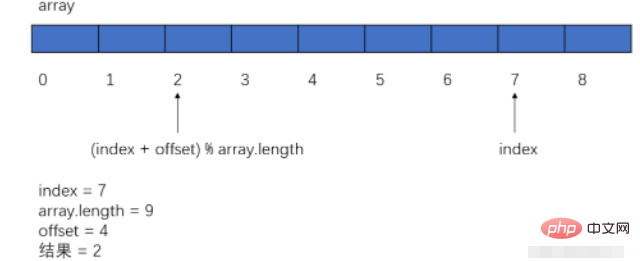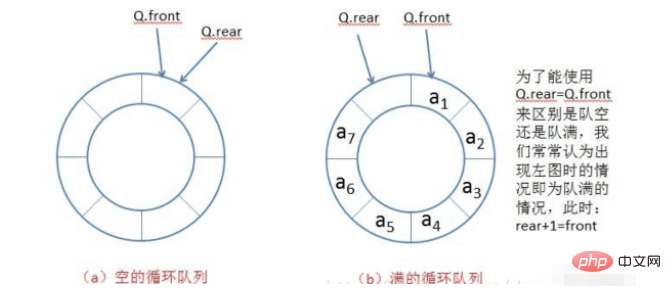How to implement Java stack and queue
1. Implement circular queue
[OJ link]
Circular queue is generally implemented through an array. We need to solve several problems.
(1) Array subscript implements loop
a, the subscript finally goes back (offset is less than array.length): index = (index offset) % array.length. To put it more simply, if the size of our array is 8 and the subscript reaches 7, then how to return to 0, we can achieve it by (index 1)%8.

b. When the subscript is the first and then forward, we make a special judgment and set it to the array size minus one.
(2) Distinguish between full and empty queues
We can reserve a position for the array. If rear 1=front, it means that the queue is full; if rear=front, it means that the queue is null. In this case, we need to consider the queue size. When defining the array size, it needs to be one larger than the original one.

[The code is as follows]
class MyCircularQueue {
public int front;
public int rear;
public int[] array;
//构造方法
public MyCircularQueue(int k) {
//因为预留位置的缘故,数组的大小要定义为k+1
this.array=new int[k+1];
}
//入队
public boolean enQueue(int value) {
if(isFull()){
return false;
}
this.array[this.rear]=value;
this.rear=(this.rear+1)%this.array.length;
return true;
}
//出队
public boolean deQueue() {
if(isEmpty()){
return false;
}
this.front=(this.front+1)%this.array.length;
return true;
}
//获取队头
public int Front() {
if(isEmpty()){
return -1;
}
return this.array[front];
}
//获取队尾
public int Rear() {
if(isEmpty()){
return -1;
}
int index=-1;
if(this.rear==0){
index=this.array.length-1;
}else{
index=this.rear-1;
}
return this.array[index];
}
//判断是否为空
public boolean isEmpty() {
if(this.front==this.rear){
return true;
}
return false;
}
//判断队列是否满
public boolean isFull() {
if((this.rear+1)%this.array.length==this.front){
return true;
}
return false;
}
}2. Queue implementation stack
[OJ link]
Because of the stack First-in-last-out, first-in-first-out principle for queues. We need two queues to implement the stack. When both queues are empty, the stack is empty.
Push: It doesn’t matter the first time you push into the stack. Both queues are empty. Just choose a queue and put it into the queue. When you push into the stack later, there will definitely be one. The queue is not empty. Find a queue that is not empty and perform the enqueue operation.
Pop (pop): First, when the stack is empty, the pop operation cannot be performed; when the stack is not empty, there must be one queue that is empty (queue1), and one queue that is not Empty (queue2), pop size-1 elements in queue1 into queue2 (pay special attention not to put the function for finding the size of queue1 into the loop. When the queue is dequeued, its size changes), and finally The last element in queue1 is dequeued and is the return value.
Getting the top element of the stack (top): It’s almost the same as popping the stack, so I won’t go into details
[The code is as follows]
class MyStack {
private Queue<Integer> queue1;
private Queue<Integer> queue2;
//构造方法
public MyStack() {
queue1=new LinkedList<>();
queue2=new LinkedList<>();
}
//入栈
public void push(int x) {
if(!queue2.isEmpty()){
queue2.offer(x);
}else{
queue1.offer(x);
}
}
//出栈
public int pop() {
if(empty()){
return -1;
}
if(queue1.isEmpty()){
int size=queue2.size();
for(int i=0;i<size-1;++i){
int x=queue2.poll();
queue1.offer(x);
}
return queue2.poll();
}else{
int size=queue1.size();
for(int i=0;i<size-1;++i){
int x=queue1.poll();
queue2.offer(x);
}
return queue1.poll();
}
}
//获取栈顶元素
public int top() {
if(empty()){
return -1;
}
if(queue1.isEmpty()){
int x=-1;
int size=queue2.size();
for(int i=0;i<size;++i){
x=queue2.poll();
queue1.offer(x);
}
return x;
}else{
int size=queue1.size();
int x=-1;
for(int i=0;i<size;++i){
x=queue1.poll();
queue2.offer(x);
}
return x;
}
}
//判断栈是否为空
public boolean empty() {
if(queue1.isEmpty()&&queue2.isEmpty()){
return true;
}
return false;
}
}3. Stack implementation queue
[OJ link]
Still the same as above, two stacks (stack1, stack2) are needed. Different from the implementation of stack queue, enqueueing can only operate on the same stack. If both stacks are empty, the queue is empty.
Enter the team (push): It is specified that stack1 is used to join the team. Each time you join the queue, just push stack1 into the stack.
Dequeue (pop): Requires stack2 to perform dequeue operation. If the queue is empty, the dequeue operation cannot be performed. When stack2 is empty, we need to pop all elements in stack1 into stack2, and then pop stack2. If stack2 is not empty, just pop stack2 directly.
Get the beginning element of the queue (peek): It is the same as the pop operation. In the end, you only need to get the top element of stack2.
[The code is as follows]
class MyQueue {
private Stack<Integer> stack1;
private Stack<Integer> stack2;
//构造方法
public MyQueue() {
stack1=new Stack<>();
stack2=new Stack<>();
}
//入队操作
public void push(int x) {
stack1.push(x);
}
//出队操作
public int pop() {
if(stack2.empty()){
int size=stack1.size();
for(int i=0;i<size;++i){
int x=stack1.pop();
stack2.push(x);
}
}
return stack2.pop();
}
//获取队列开头的元素
public int peek() {
if(stack2.empty()){
int size=stack1.size();
for(int i=0;i<size;++i){
int x=stack1.pop();
stack2.push(x);
}
}
return stack2.peek();
}
//判断队列是否为空
public boolean empty() {
if(stack1.empty()&&stack2.empty()){
return true;
}
return false;
}
}4. Implement the minimum stack
[OJ link]
In fact, it is to be in O( 1) Find the smallest element of the stack within the time complexity. Two stacks are needed to implement it, and one stack is used for popping and pushing operations. Just make sure that no matter how you operate, the top element of the other stack is the smallest element of the current stack.
Two stacks stack1 and stack2, the operations of the station are all in stack1:
Pushing to the stack: If it is pushed to the stack for the first time, we need to put it too In stack2, when pushed onto the stack, the pushed element is compared with the top element of stack2. If it is smaller than the top element of stack2, it is put into stack2.
Pop: When popping stack1, compare it with the top element of stack2. If it is equal to the top element of stack2, pop stack2.
This ensures that the top element of stack2 is always the smallest element of stack1. Note: If two identical minimum elements are pushed into stack1, stack2 needs to be pushed into the stack.
[The code is as follows]
class MinStack {
private Stack<Integer> stack1;
private Stack<Integer> stack2;
//构造方法
public MinStack() {
stack1=new Stack<>();
stack2=new Stack<>();
}
//入栈
public void push(int val) {
stack1.push(val);
if(stack2.empty()){
stack2.push(val);
}else{
if(val<=stack2.peek()){
stack2.push(val);
}
}
}
//出栈
public void pop() {
int x=stack1.pop();
if(x==stack2.peek()){
stack2.pop();
}
}
//获取栈顶元素
public int top() {
return stack1.peek();
}
//获取栈的最小元素
public int getMin() {
return stack2.peek();
}
}The above is the detailed content of How to implement Java stack and queue. For more information, please follow other related articles on the PHP Chinese website!

Hot AI Tools

Undresser.AI Undress
AI-powered app for creating realistic nude photos

AI Clothes Remover
Online AI tool for removing clothes from photos.

Undress AI Tool
Undress images for free

Clothoff.io
AI clothes remover

Video Face Swap
Swap faces in any video effortlessly with our completely free AI face swap tool!

Hot Article

Hot Tools

Notepad++7.3.1
Easy-to-use and free code editor

SublimeText3 Chinese version
Chinese version, very easy to use

Zend Studio 13.0.1
Powerful PHP integrated development environment

Dreamweaver CS6
Visual web development tools

SublimeText3 Mac version
God-level code editing software (SublimeText3)

Hot Topics
 1663
1663
 14
14
 1419
1419
 52
52
 1313
1313
 25
25
 1264
1264
 29
29
 1237
1237
 24
24
 Break or return from Java 8 stream forEach?
Feb 07, 2025 pm 12:09 PM
Break or return from Java 8 stream forEach?
Feb 07, 2025 pm 12:09 PM
Java 8 introduces the Stream API, providing a powerful and expressive way to process data collections. However, a common question when using Stream is: How to break or return from a forEach operation? Traditional loops allow for early interruption or return, but Stream's forEach method does not directly support this method. This article will explain the reasons and explore alternative methods for implementing premature termination in Stream processing systems. Further reading: Java Stream API improvements Understand Stream forEach The forEach method is a terminal operation that performs one operation on each element in the Stream. Its design intention is
 PHP: A Key Language for Web Development
Apr 13, 2025 am 12:08 AM
PHP: A Key Language for Web Development
Apr 13, 2025 am 12:08 AM
PHP is a scripting language widely used on the server side, especially suitable for web development. 1.PHP can embed HTML, process HTTP requests and responses, and supports a variety of databases. 2.PHP is used to generate dynamic web content, process form data, access databases, etc., with strong community support and open source resources. 3. PHP is an interpreted language, and the execution process includes lexical analysis, grammatical analysis, compilation and execution. 4.PHP can be combined with MySQL for advanced applications such as user registration systems. 5. When debugging PHP, you can use functions such as error_reporting() and var_dump(). 6. Optimize PHP code to use caching mechanisms, optimize database queries and use built-in functions. 7
 PHP vs. Python: Understanding the Differences
Apr 11, 2025 am 12:15 AM
PHP vs. Python: Understanding the Differences
Apr 11, 2025 am 12:15 AM
PHP and Python each have their own advantages, and the choice should be based on project requirements. 1.PHP is suitable for web development, with simple syntax and high execution efficiency. 2. Python is suitable for data science and machine learning, with concise syntax and rich libraries.
 PHP vs. Other Languages: A Comparison
Apr 13, 2025 am 12:19 AM
PHP vs. Other Languages: A Comparison
Apr 13, 2025 am 12:19 AM
PHP is suitable for web development, especially in rapid development and processing dynamic content, but is not good at data science and enterprise-level applications. Compared with Python, PHP has more advantages in web development, but is not as good as Python in the field of data science; compared with Java, PHP performs worse in enterprise-level applications, but is more flexible in web development; compared with JavaScript, PHP is more concise in back-end development, but is not as good as JavaScript in front-end development.
 PHP vs. Python: Core Features and Functionality
Apr 13, 2025 am 12:16 AM
PHP vs. Python: Core Features and Functionality
Apr 13, 2025 am 12:16 AM
PHP and Python each have their own advantages and are suitable for different scenarios. 1.PHP is suitable for web development and provides built-in web servers and rich function libraries. 2. Python is suitable for data science and machine learning, with concise syntax and a powerful standard library. When choosing, it should be decided based on project requirements.
 Java Program to Find the Volume of Capsule
Feb 07, 2025 am 11:37 AM
Java Program to Find the Volume of Capsule
Feb 07, 2025 am 11:37 AM
Capsules are three-dimensional geometric figures, composed of a cylinder and a hemisphere at both ends. The volume of the capsule can be calculated by adding the volume of the cylinder and the volume of the hemisphere at both ends. This tutorial will discuss how to calculate the volume of a given capsule in Java using different methods. Capsule volume formula The formula for capsule volume is as follows: Capsule volume = Cylindrical volume Volume Two hemisphere volume in, r: The radius of the hemisphere. h: The height of the cylinder (excluding the hemisphere). Example 1 enter Radius = 5 units Height = 10 units Output Volume = 1570.8 cubic units explain Calculate volume using formula: Volume = π × r2 × h (4
 PHP's Impact: Web Development and Beyond
Apr 18, 2025 am 12:10 AM
PHP's Impact: Web Development and Beyond
Apr 18, 2025 am 12:10 AM
PHPhassignificantlyimpactedwebdevelopmentandextendsbeyondit.1)ItpowersmajorplatformslikeWordPressandexcelsindatabaseinteractions.2)PHP'sadaptabilityallowsittoscaleforlargeapplicationsusingframeworkslikeLaravel.3)Beyondweb,PHPisusedincommand-linescrip
 PHP: The Foundation of Many Websites
Apr 13, 2025 am 12:07 AM
PHP: The Foundation of Many Websites
Apr 13, 2025 am 12:07 AM
The reasons why PHP is the preferred technology stack for many websites include its ease of use, strong community support, and widespread use. 1) Easy to learn and use, suitable for beginners. 2) Have a huge developer community and rich resources. 3) Widely used in WordPress, Drupal and other platforms. 4) Integrate tightly with web servers to simplify development deployment.




